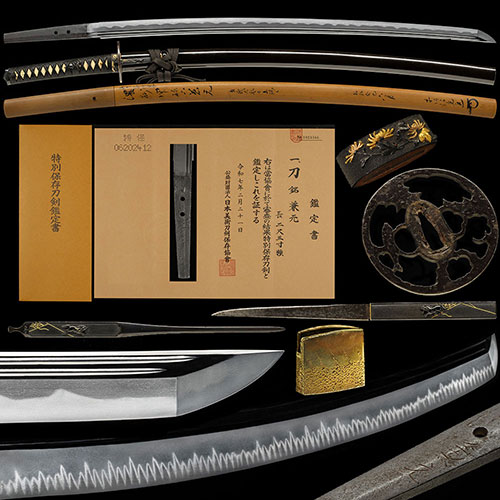
兼元 刀 Kanemoto Katana
No.570896兼元 小浜酒井家伝来孫六 時代黒蝋色塗鞘打刀拵付 金筋砂流し幾重にも掛り地刃冴える三本杉典型名品 二尺三寸一分Kanemoto, Handed down by the Obamasakai family, Magoroku, With Jidai Kuro-Rouiro Nurisaya Uchigatana Koshirae, Kinsuji and Sunagashi hangs over and over, Jiba is clear, A typical masterpiece of Snabonsugi, 69.9cm
ご成約Sold
- 銘表Mei-Omote
- 兼元兼元 Kanemoto
- 登録証Registration
- 東京都 Tokyo 昭和26年3月15日 3/15/26(Showa)
- 時代Period
- 室町後期大永頃Late Muromachi period, Around Daiei period
- 法量Size
-
刃長 69.9cm (二尺三寸一分) 反り 1.2cm
元幅 2.95cm 先幅 2.05cm 元重 0.57cm 鎬厚 0.69cm 先重 0.52cm 鋒長 3.4cm 茎長 17.1cm 重量 694gHachou 69.9cm (二尺三寸一分) Sori 1.2cm
Moto-Haba 2.95cm Saki-Haba 2.05cm Moto-Kasane 0.57cm Shinogi-Thikess 0.69cm Saki-Kasane 0.52cm Kissaki-Chou 3.4cm Nakago-Chou 17.1cm Weight 694g - 国Country
- 美濃Mino
- 姿Shape
- 鎬造、庵棟、身幅広く、反り尋常、中鋒。Shinogidukuri, Iorimune, Wide Mihaba, Standard Sori, Chu-Kissaki
- 鍛Kitae
- 板目肌に、杢目肌交じり、地沸微塵に厚くつき、地景入り、淡く映り立つ。Itamehada, Mixed Mokumehada, Jinie entered fine and thick, Chikei entered, Faintly Utsuritatsu.
- 刃文Hamon
- 互の目が連れ、尖り刃交じり、足よく入り、小沸深くつき、金筋・砂流し幾重にも頻りに掛り、匂口明るく冴える。Gunome-tsure, Mixed Togariba, Ashi entered well, Small-Nie entered deeply, Kinsuji and Sunagashi hangs over and over, Nioikuchi is bright and clear.
- 帽子Boushi
- のたれ込んで小丸、先掃きかける。Notarekonde-Komaru, Sakihakikakeru
- 茎Nakago
- 磨上、先浅い栗尻、鑢目鷹ノ羽、目釘孔二。Suriage, Tip Shallow Kurijiri, Yasurime-Takanoha, Mekugiana are two(2).
- ハバキHabaki
- 金着一重。Single Kinkise.
- 拵Sword mounitings
- 黒蝋色塗鞘打刀拵[江戸時代]
法量
長さ96.6cm反り3.6cm
説明
鐔 鉄地透、 頭 角。 縁 赤銅魚子地枝菊図金色絵。 目貫 赤銅牛図。 小柄・笄 銘 後藤光煕 花押 赤銅魚子地馬図金色絵。後藤光煕は後藤一乗の兄で次左衛門家の五代目。Kuro-Rouiro(Black wax-colored) Nurisaya Uchikatana Koshirae(Edo period)
Length: 96.6cm
Sori:3.6cm
Tsuba: Tetsuji-Sukashi
Kashira:Tsuno(Horn)
Fuchi: Syakudounanakoji Edakikuzu(branches and chrysanthemums) Kiniroe
Menuki:Syakudou Ushi(Cow)zu
Koduka/Kougai: Mei: Goto Kouki Kaou Syakudounanakoji Uma(Horse)zu Kiniroe
Goto Kouki was the older brother of Goto Ichijo and the fifth generation head of the Jizaemon family.
- 彫物Carving
- 表裏に二筋樋を掻き流す。Two lines of Hi are swept away on the front and back.
- 説明Drscription
- 兼元は、美濃三阿弥系の鍛冶で、古来名高いのは室町中期大永(1521年〜)頃の二代兼元(通称孫六)で、末古刀の最上作として二代兼定と共に末関を牽引し、また、最上大業物としても知られるように切れ味に優れ、古来より武人に愛された。二代兼元以降代々孫六を通称としているが、「関の孫六三本杉」といわれるように兼元の代表的な刃文が三本杉乱れで、これは尖りごころの互の目が連なる様が三本杉のように見えたことからついた呼び名である。この刀は、身幅広く、反りやや浅く、中鋒、茎が短い片手打の姿で、板目に杢目交じり、刃寄り流れ肌交え、地沸微塵に厚くつき、地景入り、淡く映りが立つ明るく冴えた地鉄に、焼き幅大きく華やかで典型的な三本杉を焼き、小沸深くつき、金筋・砂流し幾重にも頻りに掛るなど刃中盛んに働き、匂口明るく冴える。本阿弥光遜の鞘書が入る小浜酒井家伝来の名品である。Kanemoto is a blacksmith of the Mino SanMiami lineage, and the one who has been famous since ancient times is the second Kanemoto (commonly known as Magoroku), who lived in the middle of the Muromachi period and was known as Magoroku. , Also known as the best Ohwazamono, it has excellent sharpness and has been loved by warriors since ancient times.
Since Kanemoto II, he has been known by the common name Magoroku for generations, but Kanemoto's representative Hamon is Sanbonsugi(Three Cedars)-Midare, as it is said to be ``Seki no Magoroku Sanbonsugi(Three Cedars)'', which looks like a pair of eyes with a pointed heart. It is the name given because it looked like Sanbonsugi(Three Cedars).
This sword has Wide Mihaba, Slightly shallow Sori, Chu-Kissaki, The Nakago is a short one-handed forging. Itame with mixed Mokume, Hatori-mixed nagarehada, Jinie entered fine and thick, Chikei entered, Faintly Utsuritatsu with bright and clear Jigane, Big Yakihaba, It is a typical Sanbonsugi with Big Yakihaba and gorgeously, Small-Nie entered deeply, Kinsuji, Sungashi entered over and over, It works well in sword, Nioikuchi is bright and clear. It is a masterpiece handed down through the Obamasakai family and bears the inscription by Honami Koson.



